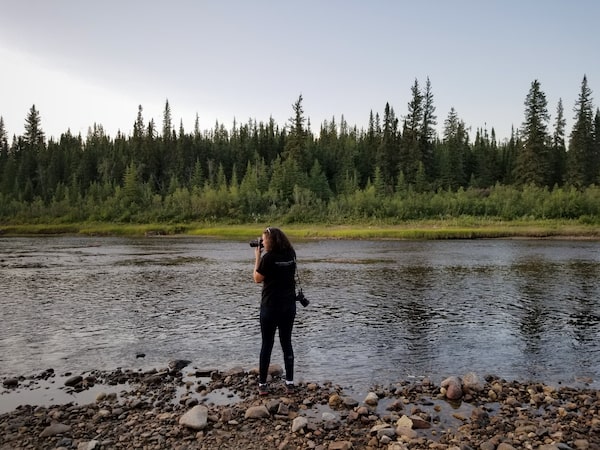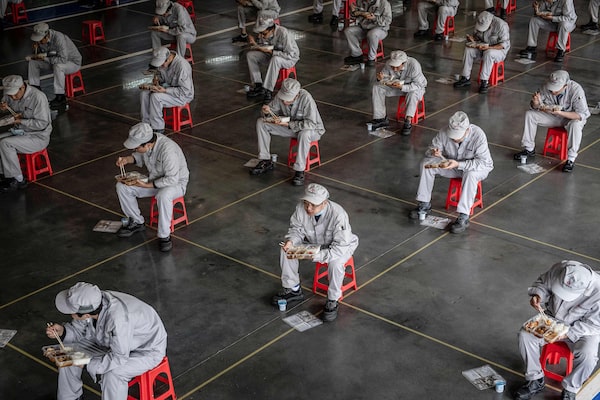This is the weekly Amplify newsletter. If you’re reading this on the web or someone forwarded this e-mail newsletter to you, you can sign up for Amplify and all Globe newsletters here.

Photographer Melissa Tait is pictured here in Northern Manitoba on assignment during the manhunt of Canadian fugitives Kam McLeod and Bryer Schmegelsky, in July 2019.Renata D'Aliesio
It’s a cliché, but it’s true: A picture is worth a thousand words. The Globe’s team of photojournalists has been on the forefront of our coronavirus coverage for weeks, capturing both haunting and heartwarming images, which readers would never see from the confines of their homes.
On Wednesday night, I caught up with Globe photographer Melissa Tait on a video conference call to get a sense of what it’s been like covering the story of her career (so far), and the challenges of recording history from a distance.
Melissa, I see we’re both having a drink right now, so “cheers …”
[Laughs] Cheers!
How are you holding up?
It’s daunting to think that this is how it’s going to be for a while, but I’m so lucky my actual job is also focused on it because I’d be more of a distracted mess otherwise. [Laughs]
You tweeted last night about covering the manhunt for two Canadian fugitives last summer, which was a pretty wild story at the time. I think that tweet captured what many of us are feeling right now – this sense that the world was already a bit crazy and now this happens.
Yeah, totally.
This pandemic kind of crept up on a lot of us. We knew about it happening in China, and then Italy … and then suddenly it was on our doorstep. When did it hit you that this was a very, very big deal?
It’s funny how my brain figured that out. I sit with [Globe health reporters] Kelly, Carly and Wency and they’d been working gangbusters on this file for a week or so. And I have the distinct memory of Nicole [lead editor on the coronavirus coverage] coming up to Kelly around the time the guy from the PDAC conference tested positive for coronavirus … and she said, “Okay, I think we need to go all hands on deck.” And when I heard her say that, I knew. I knew this story was going to roll.
One of things that’s so striking about this story is how quickly it moves.
Yeah. Even our video explainer is kind of out of date … it says wash your hands and if you’re sick, stay away from other people. Now, it’s like: Just stay home. Doesn’t matter if you’re sick or not. Stay home.
You’re working from home now, like almost all of us are. What’s a typical day for you like these days?
My typical day is, get up … walk to my desk –
What is that, like 30 or 40 feet away?
[Laughs] Yeah, I live in like a 500-square foot apartment. Actually, I check my phone first. And I have a monitor from work and a chair from work so that’s good. And then it’s figuring out what projects we’re working on. Usually around noon or 1 p.m., photo editors start calling me to do assignments. But even then, sometimes I’ll spend an hour and half taking a photo and I send it in and my editor is like, “Oh, we’re going to go with an international photo for the front page.”
Have you ever felt unsafe?
No, I don’t feel at risk but I worry about putting other people at risk. I’m not immunocompromised, and I’m in full control of myself. I can clean myself and clean things, but I can’t control other people. I went into another person’s house a week ago, and I was very careful. I touched nothing. It’s so weird though because usually when I meet someone to photograph I shake their hands say, “I’m Melissa, nice to meet you.” Now it’s like, “Okaayyy …”
You have to be so careful.
Yeah. I do remember, too, taking a picture of a woman and she put her hand on a banister and I told her not to. It wasn’t because I was afraid she would get sick, but it’s because I thought the photo would look weird. We’re just so aware now. People would see that picture and be like, 'Why is she touching that banister?"
Yeah, it’s strange how quickly a new normal can set in. Even watching people on TV, I’m like, “Why are they standing so close?!”
Yeah. And that’s another parallel I feel to covering the manhunt. The whole way you orient yourself changes.
Any photos from the pandemic that stand out for you?
I chose this one [below] of autoworkers in China eating lunch. It’s graphically striking. At the same time it communicates a sense of togetherness and loneliness that so many of us are feeling. Plus, there are no masks, it’s not an empty town square – just people doing something normal in extraordinarily abnormal circumstances.

This photo taken on March 23, 2020, shows employees eating during lunch break at an auto plant of Dongfeng Honda, in Wuhan, in China's central Hubei province.STR/AFP/Getty Images
How are you staying sane?
Working. I know it sounds dumb, but I have journalism FOMO [fear of missing out]. The Sunday night before this story really took off I had a hard time sleeping, I could feel this gearing up, and I was up thinking about what to do and how to do it. So I’m lucky I’m working.
You’re out in the public more than most of us. What’s the mood out there?
The people I’ve met are all at a general sense of uneasiness. … but also, there’s a weird sense of community. We’re all in it. And every single person I pass on the street, I swear they’re all talking about COVID. [laughs]
How do you think we’re going to come out of this?
I’m a positive person. I think we’re going to come out of this with a bit more sympathy, a bit more empathy. I mean … I hope so. I don’t think you can go through something this uncertain and scary and not come out of it a better person.
It’s fair to say this is the biggest story you’ve ever covered?
Are you kidding me … yes, yes … 100 per cent yes.
This interview had been edited an condensed.
What else we’re thinking about:
If you’re already tired of Netflix, Zoom workouts and Marie Kondo-ing your home, you’re not alone. Finding meaningful – and safe – ways to contribute to the world might help with dealing with the anxiety of living through a pandemic. Some ideas: Donate blood, bring food to a foodbank or send money to shelters for women. Those interested in supporting photography might consider a donation to Women Photograph, which has set up an emergency fund for freelance photographers who have been hit particularly hard by COVID-19.
Inspired by something in this newsletter? If so, we hope you’ll amplify it by passing it on. And if there’s something we should know, or feedback you’d like to share, send us an e-mail at amplify@globeandmail.com.